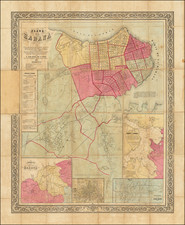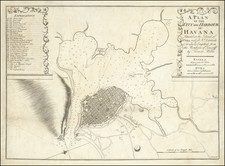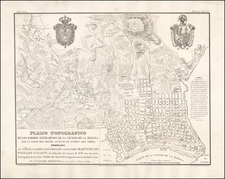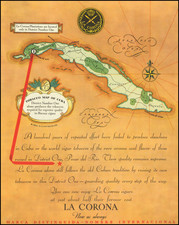Intriguing Manuscript Map of Plantation Lands in Cuba Including Coffee Plantations
Schematic manuscript sketch map of Bahía Honda, along the north coast of Cuba. The paleography indicates the map was made in the mid- to late-eighteenth century.
Oriented to the southeast, the map includes a partial north arrow and was drawn by someone with detailed knowledge of the area. The town of Bahía Honda itself is along the road to the north, as mentioned in a note at the bottom of the document. Text on the verso reads, "Plan of Lands at Bahia Honda".
The map includes roads (including a main road, or camino real, the royal road), several streams (arroyos), rivers, coffee plantations (cafetales), and a large pasture (potrero). The map is drawn with a scale in mind, as there are measurements in caballerias, a unit of measure used in Latin America.
There are two líneas de compromiso across the map. These lines are negotiated boundaries between property, in this case between haciendas and plantations. They were mediated when there were no existing documents or memory of where one property ended and the other began. In that case, lines were drawn equidistant between the main developed sites on the hacienda, bisected, if necessary, by lines through their outlying corrals or pastures.
The main purpose of this map seems to be to record or calculate these lines of compromise between three haciendas. The area was fertile for both grazing livestock and planting crops, therefore it was important to designate the extent of the properties.
Coffee was only grown in Cuba from the mid-eighteenth century. It was farmed based on a plantation system using slave labor. When this map was made, Bahía Honda, named for its deep-water port, was surrounded by agriculture and ranching. Today, it is an industrial port. The port was once leased to the United States, but it was abandoned in favor of Guantanamo Bay.












![Cuba Insula [with] Hispaniola Insula [with] Insula Jamaica [with] Ins. S. Ioannis [with] I.S. Margareta Cum Confiniis](https://storage.googleapis.com/raremaps/img/small/95802.jpg)

![(Florida, the Bahamas, and Cuba) Southern Coast U. States. Sheet VI. [joined with:] Southern Coast, U. States. Sheet VIII. [and:] Cuba and the Windward Passages](https://storage.googleapis.com/raremaps/img/small/85747.jpg)

